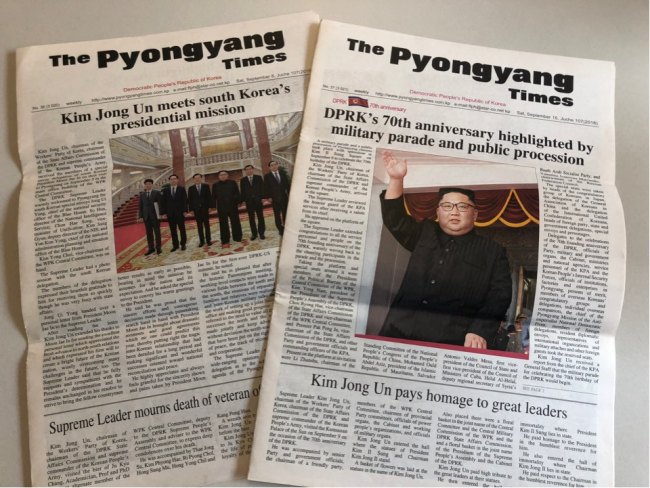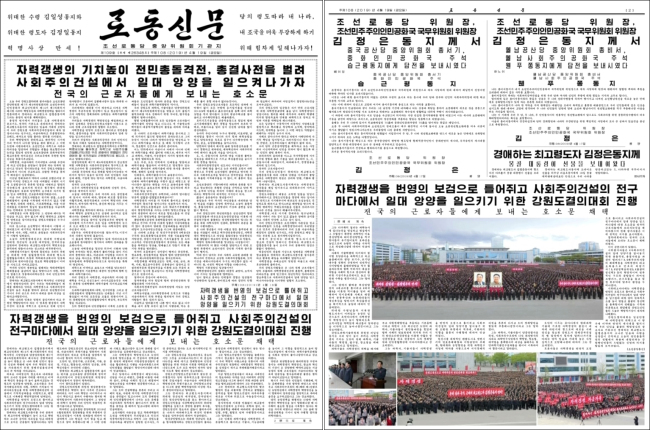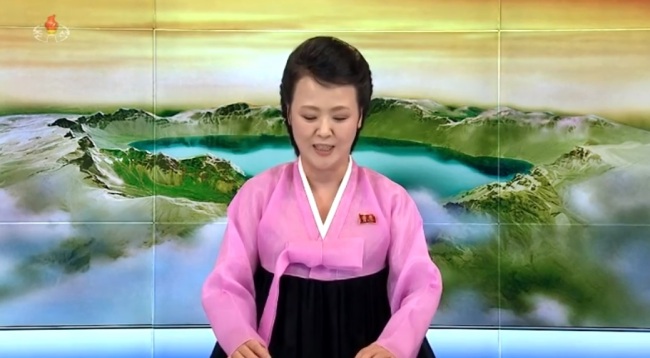[Feature] North Korean media show signs of change
State media outlets embrace YouTube, speedy reporting
By Jo He-rimPublished : April 23, 2019 - 18:53
As mysterious and closed off as is North Korea, the country is second to none when it comes to being vocal on domestic and world affairs.
While it is a rare for the communist regime to deliver its stance on an issue directly, the North’s strictly controlled state media “communicate” with the outside world and propagate its ideology.
They cover a wide range of topics -- from North Korean leader Kim Jong-un sending birthday greetings to centenarians to the regime’s denouncing of parties with which it is in conflict, such as the US.
While it is a rare for the communist regime to deliver its stance on an issue directly, the North’s strictly controlled state media “communicate” with the outside world and propagate its ideology.
They cover a wide range of topics -- from North Korean leader Kim Jong-un sending birthday greetings to centenarians to the regime’s denouncing of parties with which it is in conflict, such as the US.

As is often the case with media in communist states, the about 30 newspapers, broadcasters and magazines in the North are all state-operated, and their content and means of delivery are strictly screened.
However, experts have noticed changes in the rigid media environment under young leader Kim. Since Kim assumed power after his father’s death in 2011, the regime has launched YouTube channels and surprised the world with quick coverage of summits.
“While the media outlets have obviously been the means for the regime to deliver its diplomatic policies, it appears that their characteristics have diversified under the Kim Jong-un regime,” Cheong Seong-chang, vice president of research planning at the Sejong Institute, told The Korea Herald.
Changing reportage
Although the North Korean Constitution claims to guarantee freedom of speech and of the press, the communist regime has one of the most repressive media environments.
In the Press Freedom Index 2019, an annual ranking by Reporters Without Borders, North Korea stood second to last, behind Eritrea and before Turkmenistan, among 180 countries.
The country’s people are restricted from listening to unauthorized foreign broadcasts and possessing dissident publications. Getting caught for such acts could lead to serious punishment as they are considered “crimes against the state.”

The Kim family has ong viewed and used the media as a tool in maintaining its grip on power and propagating its communist system. Therefore, the regime is very sensitive about this tool being used against it -- even when it comes to foreign media.
When the US-based Sony Pictures Entertainment released the 2014 satirical movie “The Interview,” in which a fictional intelligence agency attempts to assassinate Kim, the North lashed out and launched a cyberattack on the company that resulted in estimated damage of $15 million
Yet this rigidity appears to be changing slowly.
Speed does not appear to be a factor when North Korean newspapers and broadcasters report on important state events. On the other hand, a typo could be considered a grave mistake.
Major media outlets, such as the Rodong Sinmun -- the official newspaper of the Central Committee of the Workers’ Party of Korea -- usually publish reports days after an event occurs.
Therefore, the world was surprised when the Rodong Sinmun splashed pictures of Kim on a night walk in Singapore on the front page of its morning paper on June 12, 2018 just hours after it happened. Kim had gone to Singapore for his first summit with US President Donald Trump.
Joo Seong-ha, a journalist from North Korea who defected to the South, said this was unprecedented and notable because the newspaper had featured the upscale environment of a foreign city, which it would have tried to hide from the public in the past.
“It is very exceptional for the Rodong Sinmun to cover an event in such short time and it is a symbolic case which reflects the changing trend of the North Korean media outlets since Kim came into office,” Joo said on his blog, Pyongyang Story Written in Seoul, on Oct. 20, 2018.
One of the reasons behind the changes may be related to Kim Yo-jong, the North Korean leader’s younger sister believed be in her early 30s. She became the director of the Propaganda and Agitation Department of the Workers’ Party of Korea in November 2014.

“Since Yo-jong’s appearance, the reporting styles of the North Korean media outlets have changed remarkably,” Joo said. “The news outlets, which were only used to idolize Kim Jong-un and propagate the positives of the regime, started to criticize the institutes that fail to properly implement Kim’s orders -- revealing their weak points.”
Embracing trends
In December 2014, the regime created its first YouTube channel, called “North Korea Today” in Korean, which promotes the “great advance and beautiful natural scenery of the DPRK and worthwhile life of the Korean people,” according to the channel’s introductory statement.
“It is often said the North uses media outlets for propaganda, to ‘brainwash’ the people,” Park Han-woo, a media and communications professor at Yeungnam University, told The Korea Herald. But the use of YouTube indicates that Pyongyang’s view has shifted.
“North Korea appears to use the YouTube channel for interpersonal communication with its viewership as well,” Park said.
While the National Security Act blocks South Koreans from accessing North Korean websites and media, YouTube channels, which are not blocked, can be viewed by users here.
Park analyzed 8,726 videos posted from Dec. 19, 2014 to Aug. 17, 2018 on North Korea Today, and found that messages delivered by the communist regime to the outside world have changed over the years.
According to his study published in the Journal of Korean Data Analysis Society last year, terms such as “peace” and “unification” appeared more frequently as inter-Korean relations thawed. Park also highlighted that words related to capitalism and the market economy, such as “factory,” “businesses,” and “science” have been used more frequently in the titles of videos recently.
“North Korea has been gradually moving away from political news for propaganda purposes and has been focusing on attracting foreign tourists and selling products recently,” Park wrote in his report.
In addition, the channel had 9,151 subscribers, and the total number of views for all videos stood at over 8.2 million as of Sept. 13, 2018.
The channel appears to have been recreated recently, after it was deleted by YouTube for security reasons. Another YouTube channel called Red Star TV was created in October 2017.
Meanwhile, North Korea has adopted new technologies and styles in its broadcast media. For instance, News presenters of Korea Central Television now speak in a softer manner against a backdrop of animated graphic screens. They had previously read the news with a painting of Pyongyang in the background.
“The media outlets in North Korea are showing signs of change to resemble those of ‘normal’ countries,” Cheong of the Sejong Institute said.
By Jo He-rim (herim@heraldcorp.com)






![[From the Scene] Monks, Buddhists hail return of remains of Buddhas](http://res.heraldm.com/phpwas/restmb_idxmake.php?idx=644&simg=/content/image/2024/04/19/20240419050617_0.jpg&u=20240419175937)




![[Graphic News] French bulldog most popular breed in US, Maltese most popular in Korea](http://res.heraldm.com/phpwas/restmb_idxmake.php?idx=644&simg=/content/image/2024/04/18/20240418050864_0.gif&u=)




![[From the Scene] Monks, Buddhists hail return of remains of Buddhas](http://res.heraldm.com/phpwas/restmb_idxmake.php?idx=652&simg=/content/image/2024/04/19/20240419050617_0.jpg&u=20240419175937)

![[KH Explains] Hyundai's full hybrid edge to pay off amid slow transition to pure EVs](http://res.heraldm.com/phpwas/restmb_idxmake.php?idx=652&simg=/content/image/2024/04/18/20240418050645_0.jpg&u=20240419100350)

![[Today’s K-pop] Illit drops debut single remix](http://res.heraldm.com/phpwas/restmb_idxmake.php?idx=642&simg=/content/image/2024/04/19/20240419050612_0.jpg&u=)